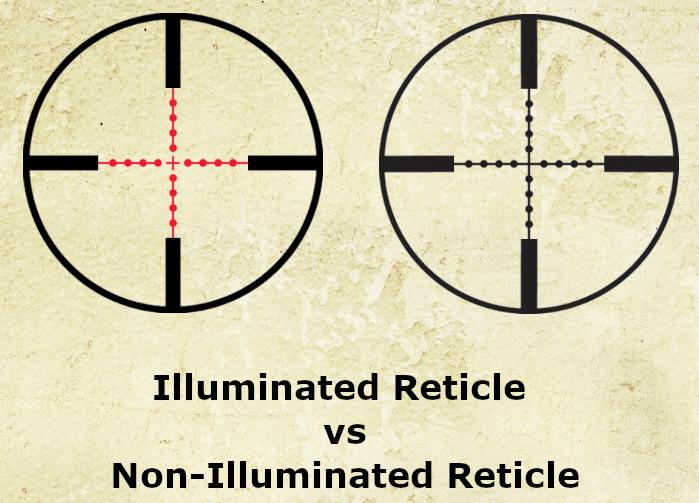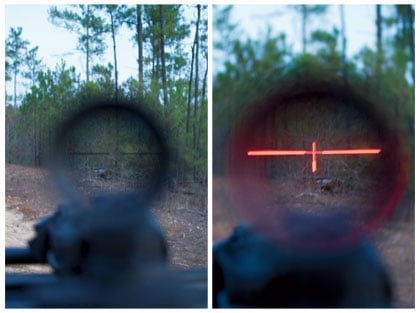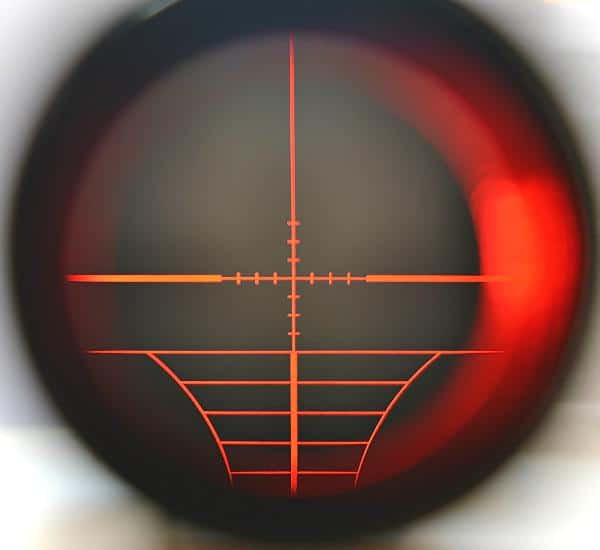Contents
- I. Introduction to Illuminated vs. Non-Illuminated Reticles
- II. Understanding the Difference between Illuminated and Non-Illuminated Reticles
- III. Benefits of Illuminated Reticles
- IV. Benefits of Non-Illuminated Reticles
- V. Factors to Consider When Choosing between Illuminated and Non-Illuminated Reticles
- VI. Frequently Asked Questions about Illuminated vs. Non-Illuminated Reticles
- 1. What is the main difference between illuminated and non-illuminated reticles?
- 2. Are illuminated reticles necessary for hunting or shooting in low light?
- 3. Can I use an illuminated reticle during daylight hours?
- 4. Do illuminated reticles affect battery life?
- 5. Are there any advantages to using a non-illuminated reticle?
- 6. Can I switch between illuminated and non-illuminated reticles?
- 7. Are illuminated reticles suitable for long-range shooting?
- 8. Do illuminated reticles affect the scope’s overall clarity?
I. Introduction to Illuminated vs. Non-Illuminated Reticles

When it comes to choosing a reticle for your firearm scope, one of the key decisions you’ll need to make is whether to go for an illuminated or non-illuminated reticle. Both options have their advantages and it’s important to understand the differences in order to make an informed choice.
The Benefits of Illuminated Reticles
Illuminated reticles, as the name suggests, have built-in illumination that enhances visibility in low-light conditions. This feature can be particularly useful during dawn, dusk, or when hunting in dense vegetation. The illuminated reticle ensures that the aiming point is clearly visible, allowing for more precise shots.
Additionally, illuminated reticles often come with adjustable brightness settings. This allows the shooter to tailor the intensity of the illumination to match the ambient lighting conditions, ensuring optimal visibility without causing eye strain.
The Advantages of Non-Illuminated Reticles
Non-illuminated reticles, on the other hand, offer their own set of advantages. These reticles are typically simpler in design and do not rely on batteries or electronics for operation. This makes them highly reliable and durable, as there are no components that can fail or run out of power.
Non-illuminated reticles also tend to be more affordable compared to their illuminated counterparts. This makes them an attractive option for shooters on a budget or those who don’t anticipate needing illumination in their shooting scenarios.
Choosing the Right Reticle for Your Needs
When deciding between illuminated and non-illuminated reticles, it’s important to consider your specific shooting requirements. If you frequently find yourself in low-light conditions or need the extra visibility provided by illumination, an illuminated reticle may be the best choice for you.
On the other hand, if you primarily shoot in well-lit environments or prefer the simplicity and reliability of a non-illuminated reticle, then opting for a non-illuminated reticle is a sensible decision.
Ultimately, the choice between illuminated and non-illuminated reticles comes down to personal preference and the shooting conditions you expect to encounter. Both options have their merits, and with a clear understanding of your needs, you can make an informed decision that enhances your shooting experience.
II. Understanding the Difference between Illuminated and Non-Illuminated Reticles

In the world of riflescopes, the choice between an illuminated and a non-illuminated reticle can make a significant difference in your shooting experience. Both types of reticles have their advantages and are suitable for different situations. In this section, we will delve into the characteristics that set them apart from each other.
I. What is an Illuminated Reticle?
An illuminated reticle is designed to offer enhanced visibility in low-light conditions. By incorporating a light source within the reticle, it provides a bright and contrasting image that improves target acquisition. This type of reticle usually has multiple brightness settings, allowing the shooter to adjust the illumination level according to the ambient lighting conditions. Illuminated reticles are particularly useful during dusk, dawn, and in heavily shaded environments.
II. Advantages of Using an Illuminated Reticle
1. Improved Target Acquisition: The illuminated reticle stands out against the background, making it easier to quickly acquire and track your target.
2. Enhanced Low-Light Performance: When light conditions are less than optimal, the illuminated reticle ensures that you maintain a clear sight picture, reducing eye strain and improving accuracy.
3. Versatility: Illuminated reticles can be used in a wide range of shooting scenarios, including hunting, tactical operations, and competition shooting.
III. What is a Non-Illuminated Reticle?
A non-illuminated reticle, also known as a standard reticle, does not feature a built-in light source. It relies solely on the ambient light to provide contrast against the target. This type of reticle is commonly found in traditional riflescopes and is suitable for most shooting conditions.
IV. Advantages of Using a Non-Illuminated Reticle
1. Simplistic Design: Non-illuminated reticles are often less complex, resulting in a cleaner sight picture and less distraction for the shooter.
2. Battery-free Operation: Since there is no need for a power source, non-illuminated reticles offer increased reliability and eliminate the concern of running out of battery power at a crucial moment.
3. Cost-effective: Non-illuminated reticles are generally more affordable than their illuminated counterparts, making them a popular choice for shooters on a budget.
V. Choosing the Right Reticle for Your Needs
When deciding between illuminated and non-illuminated reticles, you should consider the shooting conditions, your shooting style, and personal preferences. If you often find yourself shooting in low-light environments or require quick target acquisition, an illuminated reticle might be the ideal choice. On the other hand, if you prioritize simplicity, reliability, and cost-effectiveness, a non-illuminated reticle might be more suitable.
Ultimately, the decision between illuminated and non-illuminated reticles boils down to your specific shooting requirements and personal preferences. Whichever option you choose, make sure to practice and become familiar with your chosen reticle to maximize your shooting performance.
III. Benefits of Illuminated Reticles

When it comes to choosing the right reticle for your scope, the decision between illuminated and non-illuminated options can be a tough one. Each type has its own unique advantages and disadvantages. In this section, we will explore the benefits of illuminated reticles and why they may be the right choice for you.
1. Improved Visibility
One of the main advantages of illuminated reticles is their enhanced visibility, especially in low-light conditions. Whether you are hunting during dusk or dawn, or shooting in dimly lit environments, an illuminated reticle can make all the difference. The illuminated dots or crosshairs provide a bright and clear reference point, allowing for quick target acquisition and improved accuracy.
2. Increased Shooting Range
An illuminated reticle can also extend your shooting range. With traditional non-illuminated reticles, it can be challenging to aim accurately at longer distances, especially when dealing with smaller targets. The illumination in an illuminated reticle helps to create contrast and makes it easier to align your shot, even at extended ranges.
3. Versatility
Illuminated reticles offer a high level of versatility. Most illuminated reticles come with adjustable brightness levels, allowing you to customize the intensity of the illumination based on your specific needs. This versatility makes illuminated reticles suitable for a wide range of shooting applications, from hunting to tactical shooting.
4. Enhanced Target Acquisition
When time is of the essence, an illuminated reticle can significantly improve your target acquisition speed. The illuminated element of the reticle makes it stand out against the background, making it easier to quickly locate and aim at your target. This can be especially beneficial in fast-paced shooting scenarios or when hunting moving targets.
5. Increased Accuracy
The improved visibility and enhanced target acquisition provided by illuminated reticles ultimately lead to increased accuracy. With a clearer and more distinct aiming point, you can ensure that your shots hit the mark consistently. This can be particularly advantageous for precision shooters or those who engage in long-range shooting competitions.
IV. Benefits of Non-Illuminated Reticles

Non-illuminated reticles have their own set of unique advantages that make them a popular choice among hunters and precision shooters. In this section, we will explore some of the key benefits of using non-illuminated reticles.
1. Increased Battery Life
One of the main advantages of non-illuminated reticles is that they do not require batteries to function. This means that you don’t have to worry about your reticle running out of power at a crucial moment. With a non-illuminated reticle, you can rely on its performance without the need for any external power source.
2. Enhanced Durability
Non-illuminated reticles are often constructed with a simpler design compared to illuminated reticles. This simplicity translates into increased durability, making them more resistant to shocks, vibrations, and extreme weather conditions. Whether you’re hunting in rugged terrains or facing adverse weather, a non-illuminated reticle will continue to provide clear and precise aiming points.
3. Greater Affordability
Compared to their illuminated counterparts, non-illuminated reticles are generally more affordable. The absence of complex illumination systems and technology results in a lower price point, making them an attractive option for budget-conscious shooters. You can enjoy the benefits of a reliable reticle without breaking the bank.
4. Versatility
Non-illuminated reticles offer greater versatility in various shooting scenarios. Whether you’re shooting in low-light conditions or during broad daylight, a non-illuminated reticle will always provide a clear and visible aiming point. This versatility makes them suitable for a wide range of applications, including hunting, target shooting, and competitions.
5. Reduced Distraction
Some shooters find illuminated reticles distracting, especially when the illumination is too bright or when trying to focus on the target. Non-illuminated reticles eliminate this distraction, allowing shooters to concentrate better on the target and maintain a clear sight picture. This can be particularly important in high-pressure situations where split-second decisions need to be made.
V. Factors to Consider When Choosing between Illuminated and Non-Illuminated Reticles

When it comes to choosing between illuminated and non-illuminated reticles for your firearm, there are several factors that you should take into consideration. Each type of reticle has its own advantages and disadvantages, and understanding these factors will help you make an informed decision.
1. Lighting Conditions
The first factor to consider is the lighting conditions in which you will be using your firearm. If you primarily shoot in low-light environments, such as during dawn or dusk, an illuminated reticle can greatly enhance your visibility and accuracy. On the other hand, if you typically shoot in well-lit conditions, a non-illuminated reticle may be sufficient.
2. Purpose of Use
Another important factor to consider is the purpose for which you will be using your firearm. If you are using it for tactical or self-defense purposes, an illuminated reticle can be beneficial as it allows for quick target acquisition in high-stress situations. However, if you are using your firearm for precision shooting or hunting, a non-illuminated reticle may provide a clearer sight picture and better long-range accuracy.
3. Battery Life
If you opt for an illuminated reticle, it is crucial to consider the battery life of the reticle’s illumination feature. Some illuminated reticles have a shorter battery life, requiring frequent battery changes or recharging. Make sure to choose a reticle with a long-lasting battery to avoid any inconvenience during your shooting sessions.
4. Cost
Cost is another factor to consider when choosing between illuminated and non-illuminated reticles. Generally, illuminated reticles tend to be more expensive due to the additional technology involved. If budget is a concern, you may need to weigh the benefits of an illuminated reticle against the added cost.
5. Personal Preference
Ultimately, personal preference plays a significant role in the decision-making process. Some shooters simply prefer the aesthetics and functionality of illuminated reticles, while others prefer the simplicity and reliability of non-illuminated reticles. Consider your shooting style, preferences, and needs to determine which type of reticle is the best fit for you.
By considering these factors, you will be able to make an informed decision when choosing between illuminated and non-illuminated reticles. Remember, the right choice will depend on your specific shooting requirements, lighting conditions, and personal preferences.
VI. Frequently Asked Questions about Illuminated vs. Non-Illuminated Reticles
When choosing a reticle for your firearm scope, it’s important to consider whether you want an illuminated or non-illuminated reticle. Here are some frequently asked questions to help you make an informed decision:
1. What is the main difference between illuminated and non-illuminated reticles?
Illuminated reticles have built-in lighting, usually in the form of LED or fiber optics, that enhances visibility in low light conditions. Non-illuminated reticles, on the other hand, rely solely on ambient light for visibility.
2. Are illuminated reticles necessary for hunting or shooting in low light?
While not necessary, illuminated reticles can greatly improve target acquisition in low light situations. They provide a clear aiming point, making it easier to take accurate shots in dimly lit environments.
3. Can I use an illuminated reticle during daylight hours?
Yes, illuminated reticles often come with adjustable brightness settings, allowing you to use them effectively during daylight hours as well. You can adjust the intensity of the illumination to match the lighting conditions.
4. Do illuminated reticles affect battery life?
Illuminated reticles do require batteries to power the lighting system. However, the battery life can vary depending on the reticle model and brightness settings used. It’s always a good idea to carry spare batteries, especially during longer hunting trips.
5. Are there any advantages to using a non-illuminated reticle?
Non-illuminated reticles are generally more affordable and simpler in design compared to their illuminated counterparts. They may also be more durable as they don’t have electronic components that can malfunction or drain battery power.
6. Can I switch between illuminated and non-illuminated reticles?
Some scopes offer the option to switch between illuminated and non-illuminated reticles. This can be useful if you want the flexibility to adapt to different lighting conditions or personal preferences.
7. Are illuminated reticles suitable for long-range shooting?
Illuminated reticles can be highly effective for long-range shooting, especially when targeting small or distant objects. The illuminated aiming point provides better contrast against the background, making it easier to align your shot accurately.
8. Do illuminated reticles affect the scope’s overall clarity?
No, properly designed illuminated reticles should not affect the overall clarity of the scope. The illumination should only enhance the visibility of the reticle without compromising the quality of the optics.
Remember, the choice between illuminated and non-illuminated reticles ultimately depends on your specific needs and preferences. Consider factors such as lighting conditions, intended use, and budget when making your decision.
Robert Garcia is a highly skilled and passionate individual with a deep-rooted interest in firearms. With a wealth of experience in the field, Robert has honed his expertise through years of hands-on training and practical application. His educational background includes a Bachelor’s degree in Ballistics Engineering from the prestigious University of Firearms Technology, where he specialized in advanced firearm design and functionality. Additionally, Robert has undergone extensive tactical training programs, earning certifications in marksmanship and self-defense. His dedication to staying updated with the latest advancements in firearm technology and regulations is evident in his meticulous research and detailed writing.